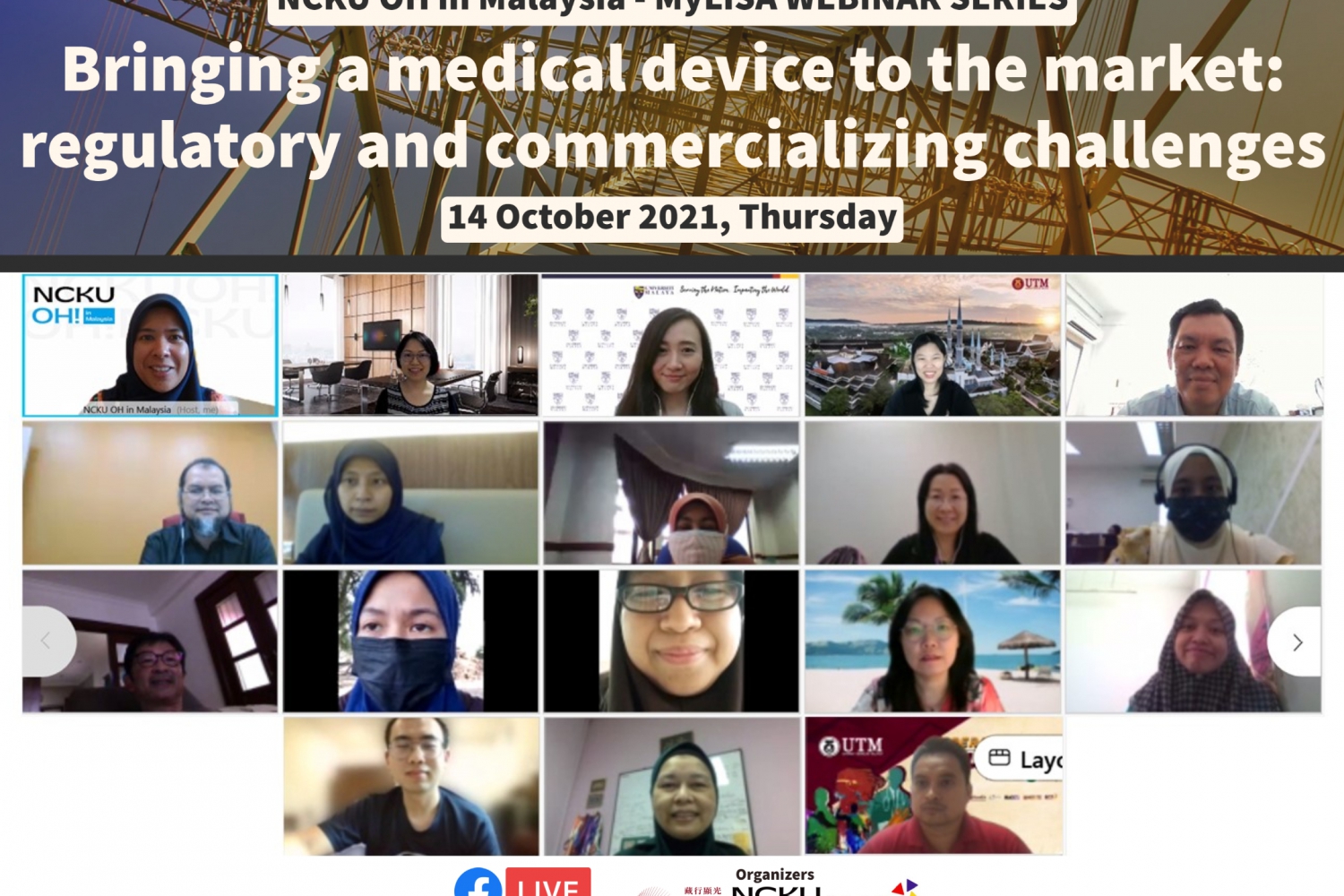Malaysia Business
[Webinar Series] Bringing a Medical Device to the Market: Regulatory and Commercializing Challenges
2021-10-14

Benefited from ever-increasing technological innovation and manufacturing of high-value local medical device, Malaysia is set to become the major healthcare hub in Asia. In parallel with this, there has been increasing efforts by the universities to translate healthcare innovations into commercially viable products. However, commercialising innovations has not historically been seen as a strength of universities. For instance, the regulatory strategy remains one of the most challenging aspects of launching a medical device. In addition, academics and researchers may not have a strong go-to-market strategy for their products. Hence, this second episode of the NCKU OH in Malaysia – MyLiSA webinar series was more focused onto looking at the strategies to navigate regulatory challenges and effective commercialisation for academics and researchers.
Three distinguished panelists were invited to discuss on the topic entitled “Bringing a medical device to the market: regulatory and commercializing challenges” - Mr. Yusuf Mohd Johari (Director of Registration, Licensing & Enforcement Division, Medical Authority (MDA), Ministry of Health Malaysia), Assoc. Prof. Peng-Ting Chen (Department of Biomedical Engineering, College of Engineering & Medical Device Innovation Center, National Cheng Kung University (NCKU), Taiwan) and Dr. Hau Yuan Wen (Senior Lecturer at School of Biomedical Engineering and Health Sciences, Universiti Teknologi Malaysia (UTM), Malaysia and Research Fellow at UTM – IJN Cardiovascular Engineering Centre). The 90-minutes discussion was led by Dr. Kwong Soke Chee (Project Manager, MyLiSA).
Mr. Yusuf Mohd Johari started his presentation by stating that any act or regulation by the MDA is very harmonized, and Malaysia are among the few countries who will be endorsing the new World Health Organization (WHO) model and will be incorporating it into their law. He then shared the two main objectives of medical device regulations: 1) To address public health and safety issues, and 2) To facilitate medical device trade and industry. In addition, Mr. Yusuf briefly mentioned on the medical device’s regulatory framework in Malaysia from pre-market, placing on-market and post-market surveillance/vigilance. The highlight of his presentation is the sharing on the establishment of licensing and registration of medical device products.
The second panelist of the webinar was Dr. Hau Yuan Wen. Her sharing session was focused on the challenges of medical device development in academia from research and development (R&D) towards commercialization. In her presentation, she touched upon the Malaysian commercialization funding landscape that supports the different Technology Readiness Level (TRL) of the research. These fundings are made available for researchers and industries to apply together in order to push the invention towards commercialization. In addition, Dr. Hau presented on the available fundings for startup, business improvement/expansion/development and export, which are beyond the TRL. Then, she brought the audience to understand her journey on bringing her product, myThrob from R&D towards commercialization. She elaborated in detail on the sets of challenges she faced in each TRL, from proof of concept to product design commercialization. Dr. Hau personally has been involved in the development of a long list of medical devices and one of her recent projects is Mitro.
The final presenter of the webinar was Assoc. Prof. Peng-Ting Chen. She delivered the presentation on behalf of Dr. Xi-Zhang Lin, a Professor from the Department of Internal Medicine, School of Medicine, NCKU. The title of the presentation was ‘The regulation of medical device should keep up with the progress of medical knowledge and in align with the regulatory system’. In Prof. Lin’s text, he wrote that “The medical device makes progress rapidly in recent decades; while the regulatory process keeps consistent with conventional and universal standards. It is not surprising to notice the discordance between the viewpoints of inventors and the regulatory inspectors. Only by bridging these two viewpoints can we focus on facilitating new products to the commercial market”. In the Q&A session, Assoc. Prof. Chen advised that researchers should be careful on the patent issue, as there is something that should not be patented. However, academicians would need a patent because ‘no patent, no talk’. A patent would serve as a good identity for researchers to be valued, but she also emphasized on the know-how on patenting.
A total of 45 participants mainly from Malaysia, Vietnam and Philippines attended the webinar. Among the participating universities were Universiti Malaya, Universiti Teknologi Malaysia, International Islamic University Malaysia and Universiti Tunku Abdul Rahman (Malaysia), De La Salle University (Philippines) and Mahidol University (Thailand). There were also industry representatives present including OSA Technologies, Flextech and DipTech. From the event survey feedback, the audiences were able to comment on what they like most regarding the webinar. Here are a few of their feedbacks, “The webinar covers the perspective from different sides and is very informative”, “The sharing of commercialization of medical device”, and “Talk about academia – commercialization”. The live webinar session is available to be re-watched at https://fb.watch/8E8_xLJkI9/.
Keyword: